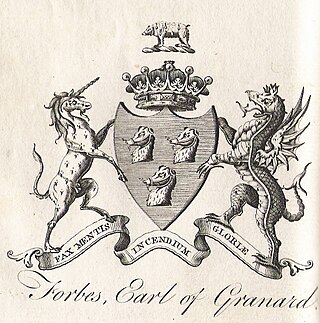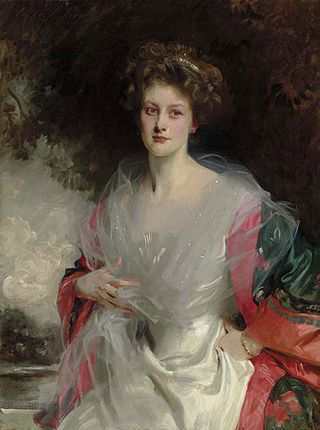Charles David Alexander John Sparrow Acheson, 7th Earl of Gosford (born 13 July 1942) is a British peer and artist. He was a member of the House of Lords from 1966 to 1999.
The son of Archibald Alexander John Stanley Acheson, 6th Earl of Gosford, and his wife Francesca Augusta Maria Cagiati, he was educated at Harrow School, the Byam Shaw School of Art, [1] and the Royal Academy Schools. [2]
On 17 February 1966, he succeeded his father as Earl of Gosford (1806), Viscount Gosford (1785), Baron Gosford of Market Hill (1776), Baron Acheson of Clancairney (1847), and Baron Worlingham of Beccles (1835), and also as the 13th Acheson baronet in the baronetage of Nova Scotia (1628). The later two baronies are in the peerage of the United Kingdom and gave him a seat in the House of Lords from 1966 to 1999. [1] He took his seat in 1977. [3] He is only recorded to have spoken there once, in 1982, in defense of native rights in the Canada Bill, and was subject to the sanction "that the noble Lord be no longer heard." [4]
He was Chairman of the Artists' Union from 1976 to 1980. [2]
In 1983, Gosford married Lynette Redmond. [1]
The former family seat was Gosford Castle, which was not lived in after 1921, when the contents were sold. The 6th Earl sold the surrounding estate to the Northern Ireland Forestry Commission in 1958. [5]

Archibald Acheson, 2nd Earl of Gosford,, styled The Honourable Archibald Acheson from 1790 to 1806 and Lord Acheson from 1806 to 1807, was a British politician who served as Lieutenant-Governor of Lower Canada and Governor General of British North America in the 19th century.

Earl of Sandwich is a noble title in the Peerage of England, held since its creation by the House of Montagu. It is nominally associated with Sandwich, Kent. It was created in 1660 for the prominent naval commander Admiral Sir Edward Montagu. He was made Baron Montagu of St Neots, of St Neots in the County of Huntingdon, and Viscount Hinchingbrooke, at the same time, also in the Peerage of England. The viscountcy is used as the courtesy title by the heir apparent to the earldom. A member of the prominent Montagu family, Lord Sandwich was the son of Sir Sidney Montagu, youngest brother of Henry Montagu, 1st Earl of Manchester, and Edward Montagu, 1st Baron Montagu of Boughton.
The Peerage of the United Kingdom is one of the five Peerages in the United Kingdom. It comprises most peerages created in the United Kingdom of Great Britain and Ireland after the Acts of Union in 1801, when it replaced the Peerage of Great Britain. New peers continued to be created in the Peerage of Ireland until 1898

Earl of Shrewsbury is a hereditary title of nobility created twice in the Peerage of England. The second earldom dates to 1442. The holder of the Earldom of Shrewsbury also holds the title of Earl of Waterford (1446) in the Peerage of Ireland and Earl Talbot (1784) in the Peerage of Great Britain. Shrewsbury and Waterford are the oldest earldoms in their peerages held by someone with no higher title, and as such the Earl of Shrewsbury is sometimes described as the premier earl of England and Ireland.

Marquess of Headfort is a title in the Peerage of Ireland. It was created in 1800 for Thomas Taylour, 2nd Earl of Bective.

Marquess of Sligo is a title in the Peerage of Ireland. It was created in 1800 for John Browne, 3rd Earl of Altamont. The Marquess holds the subsidiary titles of Baron Mount Eagle, of Westport in the County of Mayo, Viscount Westport, of Westport in the County of Mayo, Earl of Altamont, in the County of Mayo, Earl of Clanricarde and Baron Monteagle, of Westport in the County of Mayo. All these titles are in the Peerage of Ireland, except the Barony of Monteagle, which is in the Peerage of the United Kingdom. The latter peerage entitled the Marquesses to a seat in the House of Lords prior to the House of Lords Act 1999. The Earldom of Clanricarde was inherited by the sixth Marquess in 1916 according to a special remainder in the letters patent.

Marquess of Ely, of the County of Wexford, is a title in the Peerage of Ireland. It was created in 1800 for Charles Loftus, 1st Earl of Ely. He was born Charles Tottenham, the son of Sir John Tottenham, 1st Baronet, who had been created a baronet, of Tottenham Green in the County of Wexford, in the Baronetage of Ireland in 1780, by Elizabeth, daughter of Nicholas Loftus, 1st Viscount Loftus, sister and heiress of Henry Loftus, 1st Earl of Ely. In 1783 he succeeded to the Loftus estates on the death of his maternal uncle the Earl of Ely and assumed the same year by Royal licence the surname of Loftus in lieu of his patronymic. In 1785 he was raised to the Peerage of Ireland as Baron Loftus, of Loftus Hall in the County of Wexford. It was sold by the family in 1917 and is today owned by the Quigley family.

Earl of Home is a title in the Peerage of Scotland. It was created in 1605 for Alexander Home of that Ilk, 6th Lord Home. The Earl of Home holds, among others, the subsidiary titles of Lord Home and Lord Dunglass (1605) in the Peerage of Scotland, and Baron Douglas, of Douglas in the County of Lanark (1875), in the Peerage of the United Kingdom. Various Earls of Home have also claimed the title of Lord Hume of Berwick. The Earl is also Chief of the Name and Arms of Home and heir general to the House of Douglas. The title of Lord Dunglass is used as a courtesy title by the eldest son of the Earl.

Earl of Dalhousie, in the County of Midlothian, is a title in the Peerage of Scotland, held by the Chief of Clan Ramsay.

Earl of Galloway is a title in the Peerage of Scotland. It was created in 1623 for Alexander Stewart, 1st Lord Garlies, with remainder to his heirs male bearing the name and arms of Stewart. He had already been created Lord Garlies in the Peerage of Scotland in 1607, with remainder to the heirs male of his body succeeding to the estates of Garlies. This branch of the Stewart family were distant relatives of the Stewart Kings of Scotland.

Earl of Granard is a title in the Peerage of Ireland. It was created in 1684 for Arthur Forbes, 1st Viscount Granard. He was a lieutenant-general in the army and served as Marshal of the Army in Ireland after the Restoration and was later Lord Justice of Ireland. He had already succeeded his father as second Baronet of Castle Forbes and been created Baron Clanehugh and Viscount Granard in 1675, also in the Peerage of Ireland. The baronetcy, of Castle Forbes in county Longford, was created in the Baronetage of Nova Scotia on 29 September 1628 for his father, Arthur Forbes.

Earl of Gosford is a title in the Peerage of Ireland. It was created in 1806 for Arthur Acheson, 2nd Viscount Gosford.

Earl Erne, of Crom Castle in the County of Fermanagh, is a title in the Peerage of Ireland. It was created in 1789 for John Creighton, 2nd Baron Erne, who had earlier represented Lifford in the Irish House of Commons. He had already been made Viscount Erne, of Crom Castle in the County of Fermanagh, in 1781, also in the Peerage of Ireland, and sat from 1800 to 1828 as an Irish representative peer in the British House of Lords. The title of Baron Erne, of Crom Castle in the County of Fermanagh, was created in the Peerage of Ireland in 1768 for his father Abraham Creighton. The Earl was succeeded by his eldest son, the second Earl. On his death the titles passed to his nephew, the third Earl. He was an Irish Representative Peer from 1845 to 1885 and also served as Lord Lieutenant of County Fermanagh during the same period. In 1876 he was created Baron Fermanagh, of Lisnaskea in the County of Fermanagh, in the Peerage of the United Kingdom. This was to allow the Earls to sit in the House of Lords by right, rather than having to stand for election as Representative Peers. An earlier title of Baroness Fermanagh in the Peerage of Ireland was created for Mary Verney on 13 June 1792, but became extinct on her death on 15 November 1810.

Earl of Normanton is a title in the Peerage of Ireland. It was created in 1806 for Charles Agar, 1st Viscount Somerton, Archbishop of Dublin. He had already been created Baron Somerton, of Somerton in the County of Kilkenny, in 1795 and Viscount Somerton, of Somerton in the County of Kilkenny, in 1800, also in the Peerage of Ireland. Lord Normanton sat in the House of Lords from 1800 to 1809 as one of the 28 original Irish representative peer.

Baron Hesketh, of Hesketh in the County Palatine of Lancaster, is a title in the Peerage of the United Kingdom. It was created in 1935 for Sir Thomas Fermor-Hesketh, 8th Baronet, who had previously briefly represented Enfield in the House of Commons as a Conservative. As of 2010 the titles are held by his grandson, the third Baron, who succeeded his father in 1955. Lord Hesketh held junior ministerial positions in the Conservative administrations of Margaret Thatcher and John Major. However, he lost his seat in the House of Lords after the House of Lords Act 1999 removed the automatic right of hereditary peers to sit in the upper chamber of Parliament.

Archibald Alexander John Stanley Acheson, 6th Earl of Gosford,, styled Viscount Acheson until 1954, was a British peer, politician, and a Royal Air Force officer.
Archibald Charles Montagu Brabazon Acheson, 5th Earl of Gosford MC KGStJ, styled Viscount Acheson until 1922, was a British peer.

Archibald Brabazon Sparrow Acheson, 4th Earl of Gosford, was a British peer.

Archibald Acheson, 3rd Earl of Gosford KP, styled Viscount Acheson between 1807 and 1849, was a British peer and Member of Parliament.

The image used for the Palazzo Salis is the wrong one, as this shows the one at Soglio. The Countess lived at the Palazzo Salis at Bondo. I would be happy to provide you with an image of the same. You will find quite a number of views on the internet, such as this one










